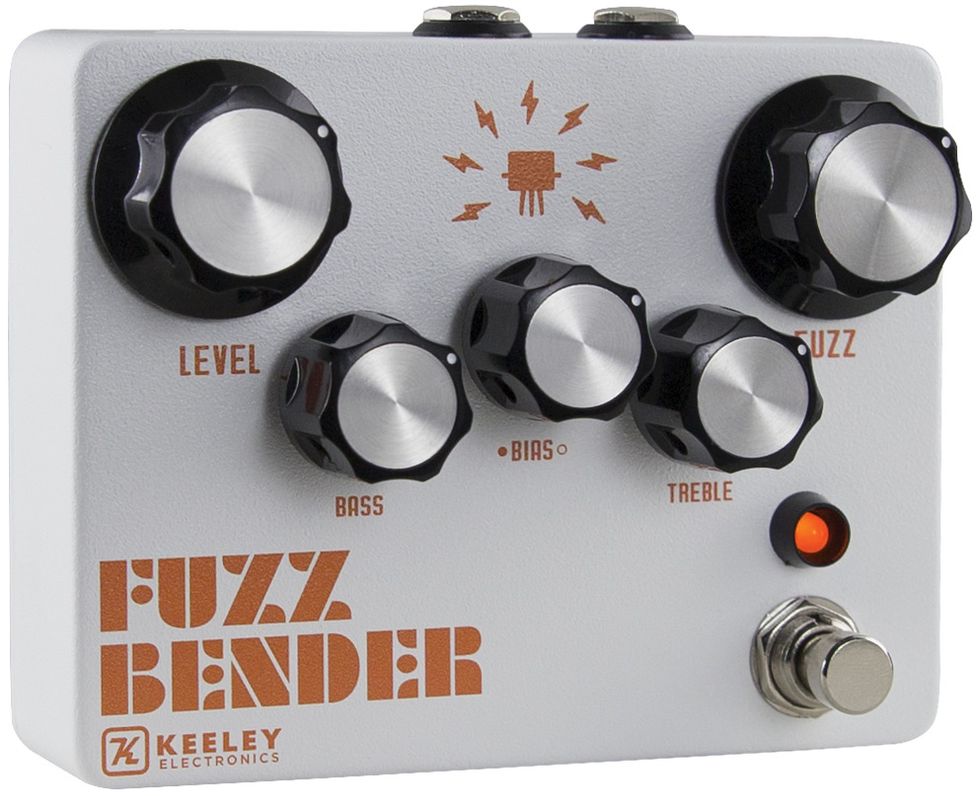RatingsPros:Well built and cleverly conceived. Great versatility and surprising range. Cons: Take care to avoid stepping on those big knobs while stomping the footswitch mid-performance. Street: $149 Keeley Fuzz Bender robertkeeley.com | Tones: Ease of Use: Build/Design: Value: |
Robert Keeley has plenty of experience taking established pedal designs in a different direction. And in the form of the Fuzz Bender, he’s added significant and original twists to the vintage 3-transistor Tone Bender template. The key differences in Keeley’s latest are a hybrid array that blends two silicon and one Japanese-made germanium transistor, and a rare active EQ stage. Vintage fuzz sounds are here in abundance, but there are also many original tones that are fun to uncover, thanks to a sensitive, wide-ranging control set.
Fuzzy Logic
Housed in a larger-format 4 1/2" x 3 3/4"x 1 1/4"enclosure, the Fuzz Bender proffers beefy fuzz and level knobs that are strategically positioned for adjusting with your foot, and smaller (though still quite large) bass, treble, and bias controls.
While they look standard enough, the two tone knobs form an active gyrator EQ stage designed to approximate the performance of mixing-desk controls, offering 20 dB of boost and cut at 100 Hz and 10 kHz, respectively. This enables you to shape a wide range of voicings that most traditional fuzzes can’t even touch. In addition, the bias knob controls how hot or cold the transistors are biased, affecting both sustain and the overall personality of the fuzz tone itself. These two design features take the Fuzz Bender well beyond simply aping vintage sounds.
Totally Biased
I tested the Fuzz Bender with single-coils, humbuckers, and both Marshall- and tweed Deluxe-style amps, and found boatloads of loveably outrétones. Although Keeley bills this as “a modern fuzz pedal”, you can still achieve quirky and authentic late-’60s or early-’70s sounds. But the powerful bass and treble controls expand on those vintage voicings considerably—adding girth and softer contours that many vintage Tone Bender- and Fuzz Face-type fuzzes can’t really touch.
And the wild bias control opens up even more possibilities. From thick, warm, and creamy to bright, spitty, splatty, and glitchy, with almost octave-divided upper harmonics, the bias control delivers much more than just dying-battery decay and ripped-Velcro sounds that extreme noise chasers enjoy. And with the ability to walk the line between able approximations of vintage classics and tones you can’t readily associate with other fuzz types, there are a lot of opportunities to shape very unique and unexpected textures.
The Verdict
The Fuzz Bender strives for originality rather than simple vintage emulation or oddball extremes. The EQ stage and bias knob are genuinely transformative controls. For all the possibilities this fairly complex control set enables, it’s not hard to find the familiar sounds that, say, Dan Auerbach or Gary Clark Jr. make their stock in trade. But there’s lots of room to craft subtle to searing original fuzz sounds to suit a recording in a very specific way and make a lead stick out like a Mardi Gras float. Yeah, I hear you—“Too many fuzzes, too little time!”—but the Keeley Fuzz Bender is definitely an alternative worth considering.







![Rig Rundown: Russian Circles’ Mike Sullivan [2025]](https://www.premierguitar.com/media-library/youtube.jpg?id=62303631&width=1245&height=700&quality=70&coordinates=0%2C0%2C0%2C0)


























